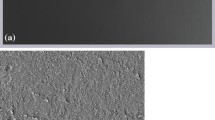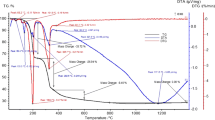The phase constitution and properties of BNC composites (with SiC and SiO2 (quartz glass) additives) are studied as functions of hot pressing temperature. The developed BNC composites have higher mechanical strength and oxidation resistance than hot-pressed BNC without additives and retain high insulating properties, thermal and chemical resistance, and good machinability.




Similar content being viewed by others
References
O. N. Grigor’ev, N. D. Bega, T. V. Dubovik, et al., “Effect of ZrO2 and SiO2 additions on phase formation and properties of hot-pressed composites based on boron carbonitride,” Ogneupory Tekh. Keram., No. 3, 18–26 (2009).
O. N. Grigor’ev, N. D. Bega, T. V. Dubovik, et al., “Effect of hot-pressing temperature on the phase formation and properties of boron carbonitride composite,” Powder Metall. Met. Ceram., 48, No. 9–10, 569–577 (2009).
O. N. Grigor’ev, N. D. Bega, and V. I. Lyashenko, “Dependence of the structure of sintered boron carbonitride on the defect level in the starting BN powder,” Powder Metall. Met. Ceram., 44, No. 5–6, 287–293 (2005).
O. N. Grigor’ev, V. A. Kotenko, and V. I. Lyashenko, “Sintered ceramics based on boron nitride and carbide,” Powder Metall. Met. Ceram., 46, No. 1–2, 46–50 (2007).
Ya. Inamura, Refractories and Their Applications [Russian Translation], Metallurgiya, Moscow (1984), p. 446.
G. G. Gnesin, Silicon Carbide Materials [in Russian], Metallurgiya, Moscow (1977), p. 215.
L. S. Ramsdell, “Studies on silicon carbide,” Am. Mineral., 32, 64–82 (1947).
G. V. Samsonov and I. M. Vinnitskii, Refractory Compounds: Handbook [in Russian], Metallurgiya, Moscow (1978), p. 558.
P. S. Kislyi, M. A. Kuzenkova, N. I. Bodnaruk, et al., Boron Carbide [in Russian], Naukova Dumka, Kiev (1988), p. 216.
0. M. Grigor'ev, B. 0. Galanov, V. A. Kotenko, et al., "Contact strength and mechanical properties of composite ceramics," in: Fundamental Landmarks of Science (Chemistry and Scientific Foundation of Advanced Technologies) (Collected Papers) [in Ukrainian], Akademperiodika, Kiev (2005), p. 304.
B. A. Galanov and 0. N. Grigor'ev, "Analytical model for indentation of brittle materials," in: Electron Microscopy and Strength of Materials [in Russian], Issue 13, Kiev (2006), pp. 4–42.
Author information
Authors and Affiliations
Corresponding author
Additional information
Translated from Poroshkovaya Metallurgiya, Vol. 50, No. 3–4 (478), pp. 89–97, 2011.
Rights and permissions
About this article
Cite this article
Grigor’ev, O.N., Dubovik, T.V., Bega, N.D. et al. Effect of silicon-containing additives on the phase constitution and properties of boron carbonitride composites. Powder Metall Met Ceram 50, 194 (2011). https://doi.org/10.1007/s11106-011-9318-9
Received:
Published:
DOI: https://doi.org/10.1007/s11106-011-9318-9




